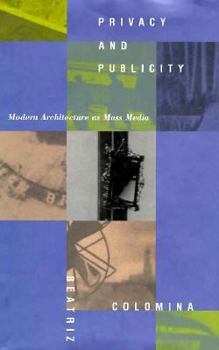Privacy and Publicity: Modern Architecture As Mass Media
Select Format
Select Condition 
Book Overview
Through a series of close readings of two major figures of the modern movement, Adolf Loos and Le Corbusier, Beatriz Colomina argues that architecture only becomes modern in its engagement with the mass media, and that in so doing it radically displaces the traditional sense of space and subjectivity.
Format:Hardcover
Language:English
ISBN:0262032147
ISBN13:9780262032148
Release Date:January 1994
Publisher:Mit Pr
Length:389 Pages
Weight:2.70 lbs.
Dimensions:10.8" x 1.3" x 7.0"
Customer Reviews
1 rating
Every designer should read this
Published by Thriftbooks.com User , 20 years ago
The best way, somtimes, to talk about a larger condition is to delve into specifics. Colomina uses Loos and Corbusier to draw out comparisons about the use of information. Considering the amount of architectural monographs being churned out on a daily basis, and the creation of terms such as "information architecture," it's extremely valuable to look at how modern architecture might have started from an alliance between types of publicity and design. Both Loos and Corbusier come out, biography-wise, as extremely creepy, though shrewd in shaping how their work is percieved by the traces that they leave behind. In Corbusier's case, he leaves an archive stuffed with minutia, an overabundance of information to supplement the built work. Loos, on the other hand, leaves very little, and thus what little remains of his work requires imagination to fill gaps in his story. What a designer can gather from this is to ask the question: how does what we do effect what our work is? Colomina's work functions reflexively as well as she works from "evidence" to create representations of both architects. It is a compelling argument, passionately written, and not the least boring.





